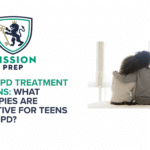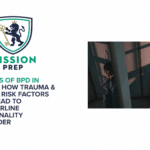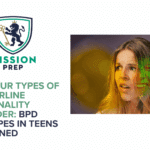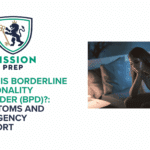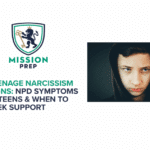Managing Teen Borderline Personality Disorder in Group Activities


Teenagers with borderline personality disorder often feel like they’re caught in emotional whiplash; one minute calm, the next overwhelmed, hurt, or ready to push everyone away.
It’s not just the mood swings that make things hard. It’s also the relationships, impulsive decisions, and deep fear of being abandoned. For teens trying to hold it together at school or home, even small issues like a group project can feel like too much.
This is where group-based support can be helpful. In the right setting, BPD group therapy for teens helps build skills that don’t always stand out in one-on-one sessions. Teens get to practice emotional regulation in group settings, work on BPD social interaction skills, and learn how to show up around peers without feeling raw or reactive.
Research shows that BPD can be caused by an interaction between genetic factors and adverse childhood experiences affecting brain development.¹ So if your child is showing signs of BPD, you likely have questions about how you can help them process hurt and move towards self-growth and regulation. For many teens, group therapy is the right fit because it allows them to feel seen, heard, and understood by peers.
This guide explores:
- How BPD shows up in teens
- The four subtypes of BPD
- BPD self-control in social settings
- BPD group therapy for teens
- Coping skills for BPD youth
- How Mission Prep can help with teamwork therapy for teens
How BPD Shows Up in Teens
For some teens, BPD shows up loudly with big emotions, sudden outbursts, and intense friendships that crash seemingly overnight. Interestingly, the expectation of fervent close friendships is a particular marker for BPD.² This shows how much importance a teen with BPD may place on having a best friend, and how distressing it can feel if the friendship falls apart.
Of course, BPD isn’t loud for all teens. For some, it’s quieter, with a constant sense of emptiness, fear of being left out, or silent shame after social interactions.³ Regardless of how it shows up, what’s going on under the surface of BPD is a nervous system on high alert and a brain that hasn’t yet learned how to trust safety in connection.⁴
These patterns aren’t about getting attention or causing drama. They’re survival strategies, driven by early experiences. And they can make everyday life hard to navigate. This is why managing emotions in teens with BPD starts with understanding what’s happening internally – not just the behaviors on the surface.
Because of trust issues and fears of abandonment and rejection, group settings can be especially intense for teens with BPD.⁵ But in teen BPD group activities, teens can begin to try out adolescent emotional expression in ways that don’t backfire. They learn to check assumptions, sit with discomfort, and see that not every shift in tone means they’ve done something wrong.
Common Signs of BPD in Teens
Some of the more common signs of BPD in teens include:
- Intense or rapidly shifting emotions
- Fear of abandonment or rejection
- Impulsive or risky behavior
- Self-harm or suicidal thoughts
- Unstable relationships with friends or family
- Identity confusion or a shaky sense of self
- Chronic feelings of emptiness
- Explosive reactions to stress or perceived criticism
When these symptoms go unrecognized, teens with BPD often feel alone and misunderstood. But in the right group setting, they can finally start to feel seen.
The Four Subtypes of BPD
There are different ways BPD can take shape, which can contribute to confusion about how it can show up. The following four subtypes of borderline personality disorder help explain why BPD can look different from teenager to teenager.
- Impulsive type: Characterized by high energy, risk-taking, and acting without thinking. Teens with this subtype may struggle to sit with discomfort, leading to reckless decisions in friendships, school, or online. Their actions can seem careless, but they’re usually attempts to escape an overwhelming inner intensity.
- Petulant type: Distinguished by struggles with moodiness, resentment, and a push-pull dynamic in relationships. Teens with this subtype may lash out when they feel misunderstood, only to withdraw moments later. These behaviors often stem from deep sensitivity and a fear of being rejected or unseen.
- Discouraged type: This subtype is marked by clinginess, anxiety, and people-pleasing, and is often mistaken for depression. Teens with this subtype tend to silence their own needs to keep others close, but internally feel lost or invisible. They may have trouble identifying who they are outside of their relationships.
- Self-destructive type: Characterized by risky behaviors and self-harm, often as a way to feel in control. Teens with this subtype might act tough or seem withdrawn, but are likely dealing with a profound sense of pain and shame. Their coping strategies might look dramatic, but they’re often about survival.
Managing Emotions: BPD Self-Control in Social Settings
For teens with BPD, social situations aren’t just challenging; they’re also emotionally loaded.⁶ As a result, teens with BPD may struggle with self-control, especially when it comes to managing their emotions.6
For example, a group conversation might seem casual on the surface, but internally, it can feel like a high-stakes test of worth, likability, and belonging. If someone doesn’t laugh at a joke, or when plans change suddenly, it’s not just annoying for a teen with BPD. It can trigger overwhelming panic, anger, or self-blame. As a result, they may respond impulsively in ways that can burn bridges or cause personal hurt.
This is where BPD self-control in social settings becomes a critical skill. Not in the sense of stuffing emotions down or pretending everything’s fine, but in learning to pause before reacting. Learning emotional regulation in group settings can help.
In fact, study outcomes recommend group therapy as an add-on for people with BPD already receiving individual psychotherapy.7 With the right structure, a therapeutic group gives teens space to mess up, reflect, and try again. They get feedback from peers, not just adults, and this matters. Practicing BPD social interaction skills in a supportive group helps teens learn to recognize when they’re spiraling and take actions to prevent emotions from taking over.
Through safe, repeatable practice, a teen’s brain can start to rewire, allowing them to adapt and respond to the ups and downs of relationships in healthy ways.

BPD Group Therapy for Teens
Group therapy designed for teens with BPD is structured and evidence-based, and teaches coping skills that allow teens to cope with emotions and build meaningful connections.
Trained and experienced clinicians guide sessions by following a specific framework. Plus, most group therapy sessions for teens with BPD include psychoeducation to help them understand their disorder and how to interact with peers in mutually fulfilling ways.
One of the most common approaches in group therapy is DBT (dialectical behavior therapy), which was developed specifically for people with borderline traits.8 In a youth DBT group exercise, teens might work on things like identifying emotional triggers, tolerating distress without reacting, or setting boundaries in relationships. These are practical lessons, often visual or movement-based, and are designed to stick.
Other group formats might include:
- Skills-based groups: These groups focus on specific tools like mindfulness or interpersonal effectiveness
- Process groups: Teens are encouraged to talk through real situations and get feedback from peers
- Creative expression groups: By using art, writing, or drama, these groups help teens externalize their experience
- Psychoeducation groups: These groups explain the science of BPD in teen-friendly language, helping them better understand and cope with their issues
The goal in each of these settings is structured group support for BPD, providing consistency, rhythm, and repair. They offer something many teens with BPD have rarely experienced: a social space where they can be themselves and still be accepted.
In short, BPD group therapy for teens is about giving them tools, letting them practice, and reminding them they don’t have to face the world alone.
Coping Skills for BPD Youth
Teamwork therapy for teens focuses on giving them practical tools they can take into daily life. In group, these skills are introduced, modeled, and practiced in a space that feels safe. However, if a teen is waiting to start therapy and needs something to bridge the gap, it can help to understand the techniques ahead of time.
The following are some of the core skills taught in BPD group therapy for youth:
- Naming the feeling before acting: When teens can say “I feel hurt” instead of going straight to anger or withdrawal, they’re less likely to explode or sabotage relationships.
- Taking a 90-second pause: Emotions often peak and begin to drop within 90 seconds. In group, teens learn to wait out that rush before reacting. Just one minute of pause can prevent a meltdown.
- Using grounding tools in public: Skills like tracing fingertips, noticing five things in the room, or slow breathing can help regulate the nervous system discreetly. These are often modeled and reinforced in peer group coping strategies.
- Checking the facts: Research shows that people with BPD tend to engage in splitting, which is a process of seeing themselves, others, and situations in black-and-white terms.9 Checking the facts can start to challenge this thinking. In group, teens learn how to reality-check assumptions, especially those fueled by fear or shame.
- Practicing saying “no”: Boundary-setting is a core part of interpersonal skills for youth. In group, teens role-play real scenarios and learn to assert themselves without guilt or aggression.
- Asking for help directly: Many BPD teens hint at distress or test others’ loyalty rather than stating what they need. Group work helps them practice being clear and direct with safe people.
- Tracking patterns: Identifying what triggers certain emotions can help teens prepare in advance. Some coping skills for BPD youth include journaling or using mood trackers as daily tools.
These strategies might sound simple, but for a teen with BPD, they can feel like learning a new language. What starts as awkward or forced in a group often becomes second nature through repetition, peer validation, and trust in the process. Instead of reacting to stress with survival instincts, teens learn that they have a choice, and that’s where real change begins.

Reach Out to Mission Prep for Teamwork Therapy for Teens
At Mission Prep, we specialize in teamwork therapy for teens that focuses on real-world emotional growth. Our group support for BPD blends evidence-based approaches with a deep understanding of how sensitive, struggling teens actually move through the world.
Through connection, accountability, and steady practice, our therapeutic groups help teens learn how to stay grounded when emotions surge, build trust with peers, and take ownership of how they show up in relationships.
If you’re ready to explore group therapy options or want to talk through what might help your teen most, contact us at Mission Prep today.
References
- Chapman, J., Jamil, R. T., Fleisher, C., & Torrico, T. J. (2025). Borderline personality disorder. In StatPearls. StatPearls Publishing. https://www.ncbi.nlm.nih.gov/books/NBK430883/
- Hessels, C. J., van den Berg, T., Lucassen, S. A., Laceulle, O. M., & van Aken, M. A. G. (2022). Borderline personality disorder in young people: Associations with support and negative interactions in relationships with mothers and a best friend. Borderline Personality Disorder and Emotion Dysregulation, 9(1), 2. https://pmc.ncbi.nlm.nih.gov/articles/PMC8734252/
- Biermann, M., Schulze, A., Vonderlin, R., Bohus, M., Lyssenko, L., & Lis, S. (2023). Shame, self-disgust, and envy: An experimental study on negative emotional response in borderline personality disorder during the confrontation with the own face. Frontiers in Psychiatry, 14, 1082785. https://pmc.ncbi.nlm.nih.gov/articles/PMC10030617/
- Austin, M. A., Riniolo, T. C., & Porges, S. W. (2007). Borderline personality disorder and emotion regulation: Insights from the Polyvagal Theory. Brain and Cognition, 65(1), 69–76. https://pmc.ncbi.nlm.nih.gov/articles/PMC2082054/
- Beeney, J. E., Hallquist, M. N., Clifton, A. D., Lazarus, S. A., & Pilkonis, P. A. (2018). Social disadvantage and borderline personality disorder: A study of social networks. Personality Disorders, 9(1), 62–72. https://pmc.ncbi.nlm.nih.gov/articles/PMC5468502/
- Roepke, S., Vater, A., Preißler, S., Heekeren, H. R., & Dziobek, I. (2012). Social cognition in borderline personality disorder. Frontiers in Neuroscience, 6, 195. https://pmc.ncbi.nlm.nih.gov/articles/PMC3543980/
- Bozzatello, P., Blua, C., Marin, G., Rocca, P., & Bellino, S. (2023). Group interpersonal psychotherapy (IPT-G) for borderline personality disorder: A randomized controlled study. Journal of Psychiatric Research, 168, 157–164. https://www.sciencedirect.com/science/article/pii/S0022395623004946
- May, J. M., Richardi, T. M., & Barth, K. S. (2016). Dialectical behavior therapy as treatment for borderline personality disorder. The Mental Health Clinician, 6(2), 62–67. https://pmc.ncbi.nlm.nih.gov/articles/PMC6007584/
- Pec, O., Bob, P., & Raboch, J. (2014). Splitting in schizophrenia and borderline personality disorder. PLOS ONE, 9(3), e91228. https://pmc.ncbi.nlm.nih.gov/articles/PMC3946324/


